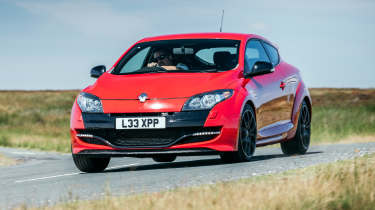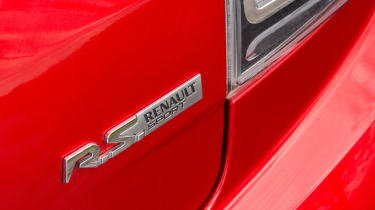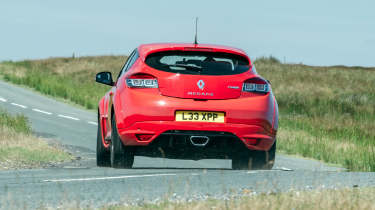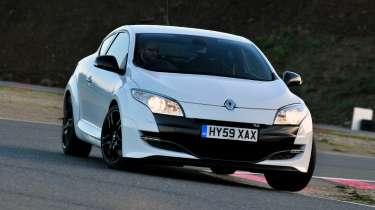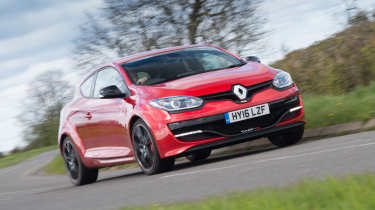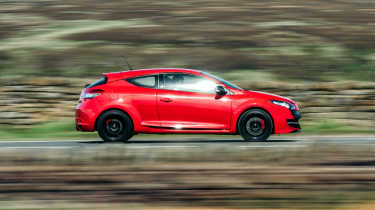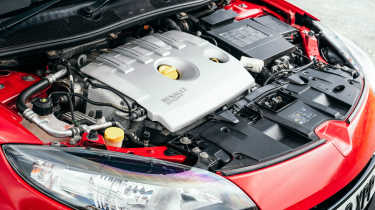Used Renault Mégane RS (Mk3, 2009 – 2016) review – the beloved French Golf GTI rival
The Renault Megane RS gets the power and torque of the limited-edition Trophy plus a range of spec upgrades, plus an F1-inspired Red Bull special edition
The third-generation Renault Sport Mégane might have been a visual revolution after to the big-bottomed R26 and R26.R that it directly succeeded but technically and in its ethos, the handsome French hot hatch was an evolution, carrying over a version of the same engine, transmission and theme of dynamic accoutrement.
Straight out of the gates the Mk3 Mégane RS was a car evo enjoyed, albeit with the caveat that it was a starting point in terms of focus, following the glorious crescendo that was the hardcore R.26R. As time and subsequent editions wore on, it got better and better, culminating in the glorious 275 Trophy R – every bit the Porsche 911 GT3 RS in hot hatch form. An enticing prospect given that most (save for the Trophy R) can be had for less than £16k. This was arguably the defining hot hatch of the 2010s and therefore, a shoo-in for our evo Eras: the 2010s test.
History and specs
The engine and transmission effectively carried over from the second-generation Mégane of the early and mid-2000s. Likewise a version of Renault’s Perfohub front end set-up that separated the steering axis from the shock absorber, aiding in the reduction of torque steer, albeit being largely constructed from aluminium here to save unsprung weight. The third-generation Mégane RS also had a subframe three-times stiffer, beefed up hubs, damper housings, struts and a stiffer rear torsion beam. The F4RT 2-litre turbocharged four-cylinder DOHC engine grew in potency gradually as subsequent versions arrived, arriving in 247bhp form initially, growing to 261bhp then finally 271bhp.
More reviews
Reviews
- Renault Megane RS Trophy-R (2019-2020) review - is Renault's record breaker worth its price tag?
- Renaultsport Mégane 275 Cup-S review - still exciting despite its old age?
- Renaultsport Mégane 275 Trophy review
- Renaultsport Megane 265 Trophy review - subtle improvements unleash the R.S' full potential
- Renaultsport Mégane 250 Cup (2010-2014) review - a good start, but there is more to come
Launched first in 250 form (referring to its power output) the third-generation RS Mégane was based on what was known at the time as the Mégane Coupe, with Cup and Sport specifications. The former omitted xenon lights and the LED DRLs in the bumper to save weight and ran a stiffer spring (35 per cent front, 28 per cent rear) and damper set-up, as well as the limited-slip differential from the Mégane R26.R up front. Confusingly, a Cup chassis option could be ticked on the standard Sport, which added the stiffer suspension, limited-slip diff and Recaro Clubsport seats – this was arguably the sweet spot of the range, all the toys both in terms of tech and dynamics.
Speaking of tech, a big new addition for the third-generation Mégane was the RS monitor. Hidden within the infotainment system’s screen (another omission in lightweight Cup spec), RS Monitor featured everything from a G-meter to a lap timer, acceleration timer and even featured control of the car’s engine map, allowing you to opt for a peaky, laggy delivery of the car’s full performance, or a reduced number but with a more linear feel and response.
The 265 Trophy was eventually launched with a boost in power (again, it’s in the name) and stickier Bridgestone RE050A tyres to differentiate it as the flagship. Minor though those changes were, they were enough to break the R26.R’s Nürburgring record by nine seconds, with an 8min 08sec time in 2011. The powertrain changes were then rolled into the updated range for 2012, with the 265 Sport and Cup. The extra power was only accessible in Sport mode. Also new for 2012 was the 30-off RB8 edition, a fully-geared Mégane RS in Red Bull colours, paying tribute to Sebastien Vettel and Red Bull’s Renault-powered F1 world championship wins of 2010 and 2011.
| Renault Sport Mégane RS 250 | Renault Sport Mégane RS 265 | Renault Sport Mégane RS 275 | |
|---|---|---|---|
| Engine | 1998cc four cylinder, petrol, turbocharged | 1998cc four cylinder, petrol, turbocharged | 1998cc four cylinder, petrol, turbocharged |
| Max power | 247bhp @ 5500rpm | 261bhp @ 5500rpm | 271bhp @ 5500rpm |
| Max torque | 251lb ft @ 3000rpm | 265lb ft @3000rpm | 265lb ft @ 3000rpm |
| 0-60 | 6.1sec | 6sec | 5.9sec |
| Top speed | 156mph | 158mph | 158mph |
| Value today | From £5k | From £6k | From £8k |
A more comprehensive facelift came in 2014 with a new face to bring the previously droop-snooted Mégane RS in line with the rest of the Renault range – new lights, grille, giant diamond and all. The 275 brought more power again, along with the hardcore Trophy and wild Trophy R. Upgrades spanning both included the bump in power, an Akrapovic exhaust to shout about it, a revised shift knob, 19-inch Speedline wheels and spectacular adjustable Öhlins dampers with composite Allevard springs, the latter being standard on the R and optional on the Trophy.
The Trophy R took things to the next level with a half cage taking the place of the rear seats and joining the upgraded springs and dampers, expensive Recaro Pole Position seats with six-point Sabelt harnesses (saving 22kg), reduced sound deadening (saving 18kg) and Michelin Pilot Sport Cup 2 tyres. It also dropped the air conditioning, radio and the multimedia system to save 10kg, though these could be optioned back in. The result: a Nürburgring time of 7:54.3 and a place among the all-time great hot hatches.
The final flourish was the 275 Cup-S. Not an even more extreme track attack version than the Trophy R, but an affordable variant that effectively democratised a number of the upgrades found on the above cars as options, including that trick suspension. Only the chopped interior and those lusty Recaro seats remained the preserve of the GT3 RS-esque Trophy R.
Renault Mégane RS on the evo Eras: the 2010s test
‘As a sports car-obsessed twentysomething, I was a bit sniffy about front-wheel-drive cars. The Mégane was the first to change my point of view, comprehensively. Here was a hatchback – albeit a specialised one – that really could be every bit as thrilling and rewarding as a two-seater sports car. (Renault Sport did release special two-seater Méganes, of course, 2014’s Ring-record-breaking 275 Trophy-R being a successor to 2008’s remarkable R26.R.)
It was also my first experience of a mechanical limited-slip differential’s effect in a front-drive car: the way getting on the throttle at the right moment can tighten the car’s line, like hooking the handle of an umbrella around a lamppost.
‘Feedback flows like electric current through the steering and pedals, and for every input you’re rewarded by an exact response. Front-end grip is one of the Mégane’s defining characteristics: buckets of bite on turn-in, chewing-gum traction on exit. There’s a little torque steer but the dual-axis front suspension does a good job of mitigating it.
'The ‘PerfoHub’ front end is a key ingredient in the RS Mégane’s secret sauce, standard to all models, but the sought-after Cup chassis option (as fitted to Richards’ car here) also added stiffer springs and dampers and 18-inch wheels. The ride is certainly firm, uncompromisingly so, but body and wheel control are so precise that it doesn’t feel crashy.
‘You access the full 261bhp map by pressing the Sport button, which also relaxes the stability control slightly. It’s a bit of a fumble to find in a shadowy corner of the dashboard. Ergonomics were never a Mk3 Mégane strong point, and I never could quite get comfortable in these cars: the gearlever always feels a bit of a stretch, and the steering wheel has an oddly flat angle, like a kart’s.
'The interior already looked dated in period and doesn’t look any fresher a decade later. And that matters not one bit: you’re having too much fun to care. Although it’s a car that loves to be driven quickly, it’s satisfying to drive at sedate speeds too, constantly immersed in the precision and immediacy of its responses.’ – James Taylor, evo deputy editor, who tested a Renault Sport Mégane RS 265 Cup on the evo Eras: the 2010s test.
What we said
Mégane RS 250 Cup (2009)
‘On the smooth stuff the Mégane 250 Cup is blistering. Despite the fact that the front wheels have to deal with 65 per cent of the 1387kg kerb weight, they rarely feel pressured. You turn in, prepare yourself for body-roll that never arrives, and soon find yourself out the other side of the corner, knowing you could have nailed the power earlier.
‘Start to work the front end harder and you realise how mobile, how active the rear is, but it moves so progressively, telegraphing its every move, that deploying it is second nature. On the rough stuff the Mégane is perhaps even more impressive. It never bites or snaps, it just serenely takes everything in its stride, utterly unruffled by quick progress.’ – Ollie Marriage, evo.co.uk, 2009
Renault Sport Mégane 265 Trophy (2011)
‘The ride is very firm, most notably at low speed over rougher urban roads, but it’s got a more supple edge than most rivals, and it’s at higher speed across more twisty, interesting tarmac that this car feels at home. Its steering could benefit from a little more feel, but is very precise, and there’s enough feedback to give you the confidence necessary to drive the Trophy very quickly. The amount of grip it finds and the lack of understeer, no matter how hot you pile into a corner, are unmatched in the large hot hatchback class.
‘If you liked the Darth Vadar-like soundtrack of the Megane R26.R, the sound of a Mégane 265 Trophy on full throttle will please you too, with its mechanical growl pretty much drowned out by a sucking induction noise.’ – Stephen Dobie, evo.co.uk, 2011.
Renault Sport Mégane 275 Trophy (2015)
‘Overall, it’s extremely hard to fault the Mégane 275 Trophy. It even sounds more appealing than the 265 thanks to the new Akrapovic titanium exhaust, which adds a bit of growl on the way up the rev range and some overrun pops on the way back down. The steering could perhaps be a smidgen tighter immediately off-centre, the touchscreen is too hard to reach (even with my long arms) and I’m not sure the Recaros hold you quite as securely as you need given the cornering forces encouraged by the chassis (the R gets huggier buckets), but these are minor niggles given the rest of the car’s talents.’ – Henry Catchpole, evo.co.uk, 2015.
Renault Sport Mégane 275 Cup S (2016)
'The engine feels up for it at all times, but you need to engage Sport mode to bump it from 247bhp to the full 271bhp. There’s a hint of torque-steer – as you’d expect from a front-drive car with a mechanical limited-slip diff – but it’s nothing to worry about, and certainly not enough to distract you. There’s tons of traction, so you can put down all the power, and the six-speed gearbox is sweet and swift in shift action. Yes, the RS Mégane is a bit long in the tooth, and no, it’s not a bargain once you’ve added the options you’re absolutely going to want to fit. But if you’re serious about your driving and want a hot hatch with pedigree, the Mégane Cup-S delivers the goods in every way that really matters. It’s a class act.' – Richard Meaden, evo.co.uk, 2015.
Renault Sport Mégane RS 250, 265 and 275 – values and buying guide
Values today are anywhere from £5k for scruffy early cars to £14k-plus for pristine later models, 275 variants in particular commanding higher prices – a sub-1000-mile Trophy R is now a £50k+ prospect while one with over 10k miles will be around £30k.
Pay close attention to options – a car with the Recaro CS bucket seats is in effect carrying an asset worth £2k and that should be reflected in the price, likewise cars that don’t have them should be cheaper. Likewise the fancy Öhlins suspension option on the 275s and the Akrapovic exhaust. The ropiest early 250s can be had for the price those options added up to on a Cup-S when new, around £5k-£7k. A nice Cup-S with all those options can be up to £20k, or around £15k with a few miles.
This is an old French hot hatch, so there are a number of things to be aware of in your search if you’re tempted. Good service and MOT history goes without saying but is doubly essential for these Renaults. Firstly, the engines are very maintenance sensitive, with a comprehensive belt and ancillary refresh needed in regular intervals – three years for the auxiliary belt and five years (or 70,000 miles) for the timing belt.
These F4R engines (naturally aspirated in the Clios going back to the old 172 and turbocharged in Méganes, from the old 225 to the last Trophy R) have been known to self destruct from a snapped belt. Secondly, these are popular driver’s cars, for good reason. As such they see plenty of enthusiast action on the road and on track. A car driven twice as hard is a car needing twice the TLC. Be sure yours has been pampered, with the history to back it up.
Other problem areas include worn hub pivots, upper gearbox mount bolts and grumbly differentials on cars fitted with the limited-slip item. Also look for wear on the interior and electrical gremlins (those annoying card keys are notoriously troublesome).
